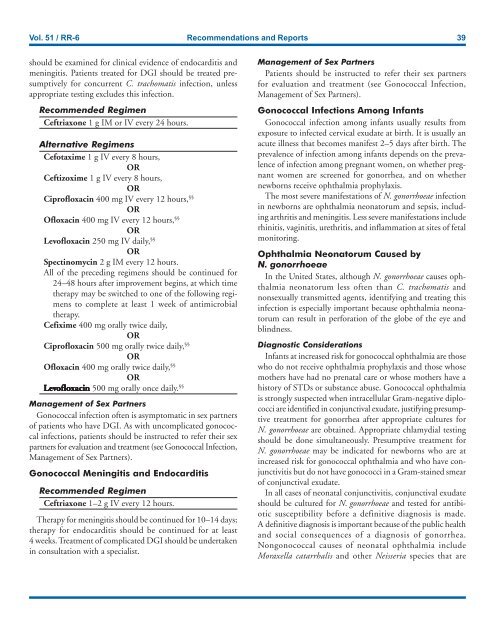You also want an ePaper? Increase the reach of your titles
YUMPU automatically turns print PDFs into web optimized ePapers that Google loves.
Vol. 51 / RR-6 Recommendations and Reports 39<br />
should be examined for clinical evidence of endocarditis and<br />
meningitis. Patients treated for DGI should be treated presumptively<br />
for concurrent C. trachomatis infection, u<strong>nl</strong>ess<br />
appropriate testing excludes this infection.<br />
Recommended Regimen<br />
Ceftriaxone 1 g IM or IV every 24 hours.<br />
Alternative Regimens<br />
Cefotaxime 1 g IV every 8 hours,<br />
OR<br />
Ceftizoxime 1 g IV every 8 hours,<br />
OR<br />
Ciprofloxacin 400 mg IV every 12 hours, §§<br />
OR<br />
Ofloxacin 400 mg IV every 12 hours, §§<br />
OR<br />
Levofloxacin 250 mg IV daily, §§<br />
OR<br />
Spectinomycin 2 g IM every 12 hours.<br />
All of the preceding regimens should be continued for<br />
24–48 hours after improvement begins, at which time<br />
therapy may be switched to one of the following regimens<br />
to complete at least 1 week of antimicrobial<br />
therapy.<br />
Cefixime 400 mg orally twice daily,<br />
OR<br />
Ciprofloxacin 500 mg orally twice daily, §§<br />
OR<br />
Ofloxacin 400 mg orally twice daily, §§<br />
OR<br />
Lev Levoflo Lev Levoflo<br />
oflo ofloxacin oflo xacin 500 mg orally once daily. §§<br />
Management of Sex Partners<br />
Gonococcal infection often is asymptomatic in sex partners<br />
of patients who have DGI. As with uncomplicated gonococcal<br />
infections, patients should be instructed to refer their sex<br />
partners for evaluation and treatment (see Gonococcal Infection,<br />
Management of Sex Partners).<br />
Gonococcal Meningitis and Endocarditis<br />
Recommended Regimen<br />
Ceftriaxone 1–2 g IV every 12 hours.<br />
Therapy for meningitis should be continued for 10–14 days;<br />
therapy for endocarditis should be continued for at least<br />
4 weeks. Treatment of complicated DGI should be undertaken<br />
in consultation with a specialist.<br />
Management of Sex Partners<br />
Patients should be instructed to refer their sex partners<br />
for evaluation and treatment (see Gonococcal Infection,<br />
Management of Sex Partners).<br />
Gonococcal Infections Among Infants<br />
Gonococcal infection among infants usually results from<br />
exposure to infected cervical exudate at birth. It is usually an<br />
acute illness that becomes manifest 2–5 days after birth. The<br />
prevalence of infection among infants depends on the prevalence<br />
of infection among pregnant women, on whether pregnant<br />
women are screened for gonorrhea, and on whether<br />
newborns receive ophthalmia prophylaxis.<br />
The most severe manifestations of N. gonorrhoeae infection<br />
in newborns are ophthalmia neonatorum and sepsis, including<br />
arthritis and meningitis. Less severe manifestations include<br />
rhinitis, vaginitis, urethritis, and inflammation at sites of fetal<br />
monitoring.<br />
Ophthalmia Neonatorum Caused by<br />
N. gonorrhoeae<br />
In the United States, although N. gonorrhoeae causes ophthalmia<br />
neonatorum less often than C. trachomatis and<br />
nonsexually transmitted agents, identifying and treating this<br />
infection is especially important because ophthalmia neonatorum<br />
can result in perforation of the globe of the eye and<br />
blindness.<br />
Diagnostic Considerations<br />
Infants at increased risk for gonococcal ophthalmia are those<br />
who do not receive ophthalmia prophylaxis and those whose<br />
mothers have had no prenatal care or whose mothers have a<br />
history of STDs or substance abuse. Gonococcal ophthalmia<br />
is strongly suspected when intracellular Gram-negative diplococci<br />
are identified in conjunctival exudate, justifying presumptive<br />
treatment for gonorrhea after appropriate cultures for<br />
N. gonorrhoeae are obtained. Appropriate chlamydial testing<br />
should be done simultaneously. Presumptive treatment for<br />
N. gonorrhoeae may be indicated for newborns who are at<br />
increased risk for gonococcal ophthalmia and who have conjunctivitis<br />
but do not have gonococci in a Gram-stained smear<br />
of conjunctival exudate.<br />
In all cases of neonatal conjunctivitis, conjunctival exudate<br />
should be cultured for N. gonorrhoeae and tested for antibiotic<br />
susceptibility before a definitive diagnosis is made.<br />
A definitive diagnosis is important because of the public health<br />
and social consequences of a diagnosis of gonorrhea.<br />
Nongonococcal causes of neonatal ophthalmia include<br />
Moraxella catarrhalis and other Neisseria species that are


